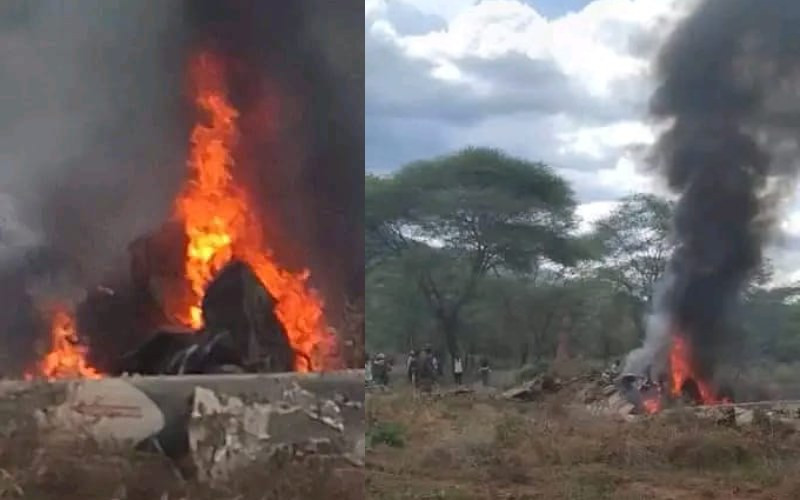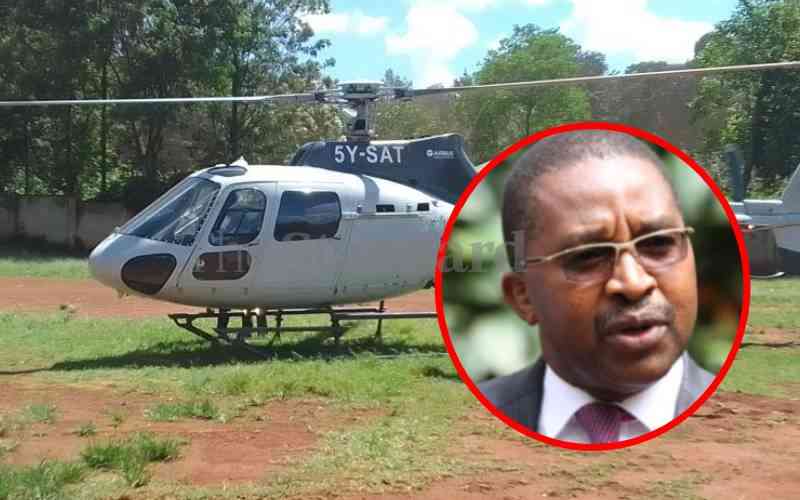 |
|
Residents assess the damage done to Pandanguo Primary School in Lamu County when unknown assailants attacked the area on Friday. PHOTOS: JONAH ONYANGO/STANDARD]. |
Coast, Kenya: The Standard on Sunday can now authoritatively reveal the name of an Al Shabaab commander who led the fighters that carried out deadly attacks in Lamu County.
Intelligence reports say that Idris Kamau, a Kenyan of Kikuyu ethnicity, was the mastermind of the spate of terror attacks in Lamu that have so far claimed 87 lives. This information is contained in a report prepared by the National Intelligence Service (NIS) and sent to police stations in the Coast region on June 4.
The alert also indicated that a former Kenya Defence Forces (KDF) soldier, Abu Jamal, is in charge of a cell of the Al Shabaab fighters in Mombasa said to be planning more attacks in the region.
The report said Kamau and his group of fighters are currently hiding in the depths of the vast Boni Forest, where they are believed to have set up an operations camp.
The alert said that the attackers were planning to carry out more raids in Mokowe and Kipini in Lamu County, Ijara, Garsen and Malindi in Kilifi County on unspecified dates. The brief report, which has been seen by The Standard on Sunday, further warned that the planned attack in Malindi is to be a massive one involving about 150 fighters divided into three groups. It further warned that the two field commanders of the terror group are planning to recruit more Muslim youth in Mombasa to undergo training for their jihadist causes at an unestablished location in or near the port city.
We could not immediately establish further details about the two Al Shabaab commanders from security forces who became uncooperative when we asked for further clarification. Although the officers were not given pictures of the two suspects, the names constitute a major development in unravelling the mystery of the attackers who have struck fear in the hearts of Lamu residents.
Our team on the ground established that the intelligence on the commanders and planned attacks was first shared with selected officers on June 27, but on July 4 it was circulated to all police stations at the Coast.
Magic potion
For nearly one month now, the attackers have melted into the forest to evade capture, much to the chagrin of security officials, one of whom likened them to “ghosts”.
“How is it possible that they can move so quickly and without us noticing? How is it possible that we have not killed one of their men despite us shooting at them? I know this might sound absurd coming from me, but, I think, they could be using some magic potion,” he said.
He could easily have been speaking of Government frustrations and anxiety of and an entire nation curious to know the face and name of an enemy who has tormented the country relentlessly in such a short time. An officer involved in the investigations told this writer that they believe the militants number between 100 and 300 and are operating out of Boni Forest near the border with Somalia. It is believed that the two commanders trained in Al Shabaab camps in Somalia before returning to Kenya to set up the cell that is operating at the coastal region. Since they began their campaign of bloodshed and destruction a month ago with an audacious 11-hour long night attack in Mpeketoni, the security forces have been unable to capture or kill any of them.
Another potential breakthrough in the investigations came on Thursday morning when seven people, among them two women, were arrested by the public in Hindi. The seven drew the suspicion of a local wine tapper when they asked him for directions to Mombasa. Seeing they were all foreigners, the wine tapper raised alarm and called the police.
When questioned, their story was not convincing enough. They claimed that they had come for a funeral and had lost directions on their way back. But it was 10 O’clock in the morning – a little too early for a funeral to have been held and concluded. Furthermore, they could not remember the particular bereaved family.
Well financed
When members of the public searched their bags, they found masks, gloves, binding cords and a map of Mpeketoni area with certain areas marked “X”. The police took the suspects to a military camp at Mokowe where they are still being interrogated. They all claimed to be residents of Watamu in Kilifi County. A police officer, who requested not to be named so as to speak freely, said one of the women named Kadzo, has implicated several prominent landowners in Lamu as key financiers of the attacks.
Stay informed. Subscribe to our newsletter
Before they were attacked last week, residents of Hindi had been scratching their heads to figure out the identities of two young men of Somali origin who recently rented a room there.
“They had wives, but they were not friendly as such and we concluded that maybe it was because they were new. However, we noticed that they were cooking a lot of food, far much more for the four of them,” said Peter Chege, a resident of Hindi.
The two had two powerful motorbikes with big carriers which they used to transport the food to unknown destinations, according to the residents.
An investigator told The Standard on Sunday that a Toyota pickup truck belonging to the son of a Hindi tycoon would occasionally, especially in the evenings, come to pick the food.
The two men and their wives disappeared on the night the attackers struck at Malamande and Hindi villages. Their whereabouts remain a mystery to investigators to date. The investigator said the financiers of the attacks are strongly suspected to be wealthy Lamu ranch owners.
“This is a well-planned, well-financed mission. We initially thought that it was just one attack but we realised that they were here for the long haul. The subsequent attacks after Mpeketoni have given us a clearer picture of who are involved and the aim of their mission,” he said.
Lamu Governor Issa Timamy has been arrested and charged by the police for crimes of murder, forcible transfer of people and terrorism. He is currently out on bond. A prominent land owner in Lamu known as Mahadi Swaleh Mahadi, alias Jesus, was this week arrested and charged with similar crimes.
A fuller picture of the events leading to the twin attacks in Mpeketoni and Kibaoni nearly a month ago is gradually emerging as the police question more suspects. Dyna Salim, the driver of one of the two matatus used in the Mpeketoni massacre, told investigators that one group of the attackers leased a matatu in King’orani, Mombasa, on the pretext that they were going for a wedding ceremony in Kipini,Lamu.
The vehicle was driven by Joseph Mututa Kithuku while his younger brother James Masila Kithuku acted as the conductor. They linked up with Salim, who was driving another car full of the attackers, in Malindi. The two brothers were killed at Mambo Sasa Forest, Salim told the police.
Investigators, however, say that Salim never reported the matter to the police as he had first told the media and was apprehended two days later at Kibaoni while trying to escape in a private vehicle. Although he claimed that the attackers had tortured and injured him, the police found no signs of torture. “He was walking well when we brought him to the station,” said one of the investigators.
Delayed response
Despite a sustained operation by the police, the attackers have largely remained elusive, for a number of reasons. For one, they have used the weather to their advantage. The attackers have mostly struck whenever it rained, limiting the movement of police vehicles in the soggy clay soil to a minimum.
They have also confused the security forces by dividing themselves and shooting from different places almost at the same time. “You will hear gunshots from three different places at once and we are at a loss on which one to follow. Some of these gunshots are just decoys, but you can never know until you get there. They are normally gone by the time we reach there,” said a police officer in Mpeketoni.
The thick, foreboding Boni Forest that stretches all the way to Somalia, has provided an ideal hiding place for the terrorists who have always managed to melt into the woodland before the security forces catch up with them.
Nonetheless, there have been many reported sightings of the attackers by local population during daytime. Delays by the police to act on tip-offs given by the public has helped them escape capture. For instance, on the day Hindi was attacked, a member of the public informed the police that she had seen strange people in military fatigues in one of the ranches there.
“That was around 11 o’clock in the morning. But no one came to check the place out. I only heard of the attack that night. I wish the police had just come that day, maybe we would have prevented another massacre,” said a the woman.
Further, a good number of suspects arrested by the public have been set free without satisfactory explanations from the police. “When members of the public arrested some five strangers on Thursday morning in Majembeni, I called my colleagues from the station to come and take them, but then they told me to let them go if they had IDs. Yes, they all had Kenyan IDs but their stories did not add up. When the people heard that the police wanted to set them free, they got so angry and wanted to lynch the suspects,” David Kahosho, a Kenya Police Reservist in Mpeketoni, told The Standard on Sunday.
Operational allowances
The suspects were later arrested by the police and are still being questioned. On Wednesday morning, Kibaoni residents intercepted 16 people of Somali origin travelling in a matatu. However, the police allowed them to proceed with their journey. Armed militia struck the offices of Amu Ranch Co-operative Society at Mihaloi that same night and made off with foodstuffs.
“We do not know whether these were attackers or not, but for sure it is a bit reckless for the police to be releasing strange people travelling in large numbers without proper investigations,” said Johnson Ndokolani, a resident of Majembeni. But the security personnel say they are in dire need of back up. Top police officers who spoke to this writer in confidence said they have been spread thin and are unable to respond to each and every call by the public. Although there was a huge presence of police immediately after the Mpeketoni attacks, their number has greatly reduced since then, even though the attacks seem to be picking pace.
“The officers who came to back us up have gone back to their stations and yet we have not received reinforcements. In addition, we have very few cars to adequately cover every possible target we would have wished to,” said the officer.
Coupled with this is the unstated unease between the KPR officers and the regular and Administration Police, an unnecessary situation wholly created by the Government. KPR officers are not formally employed by the State and do not earn any salary. However, being on the ground, they have a better grasp of the area where the attacks have taken place.
They have been of great help to the police and military when tracking down the attackers, but for some reason, the police high command has chosen to ignore their plight during the operation.
“We are required to wake up every morning and accompany police on patrol duties yet we never get anything for this like our colleagues. I have a weapon that is fit for a museum as an ornamental piece, not shooting terrorists with. I use my own money to fuel my motorbike to take me and other police officers to where police cars cannot reach yet no one compensates me for this. These officers get operation allowances but we go home every evening to our families, proud to have done our duty to our country, but with nothing to show for it,” said one of the KPR officers.
To the eternal shame of the Vigilance House, the Kenya Red Cross last week made a token donation of 10 kilogrammes of rice and similar amount of beans to the 60 KPR officers who have assisted them during the operation. The Government is yet to reward them, not even with a cent, for their efforts.
 The Standard Group Plc is a
multi-media organization with investments in media platforms spanning newspaper
print operations, television, radio broadcasting, digital and online services. The
Standard Group is recognized as a leading multi-media house in Kenya with a key
influence in matters of national and international interest.
The Standard Group Plc is a
multi-media organization with investments in media platforms spanning newspaper
print operations, television, radio broadcasting, digital and online services. The
Standard Group is recognized as a leading multi-media house in Kenya with a key
influence in matters of national and international interest.
 The Standard Group Plc is a
multi-media organization with investments in media platforms spanning newspaper
print operations, television, radio broadcasting, digital and online services. The
Standard Group is recognized as a leading multi-media house in Kenya with a key
influence in matters of national and international interest.
The Standard Group Plc is a
multi-media organization with investments in media platforms spanning newspaper
print operations, television, radio broadcasting, digital and online services. The
Standard Group is recognized as a leading multi-media house in Kenya with a key
influence in matters of national and international interest.








